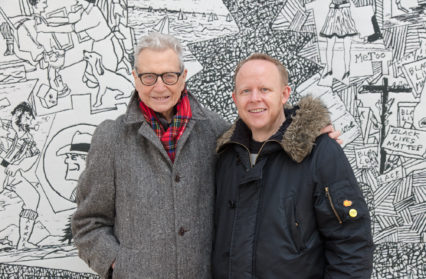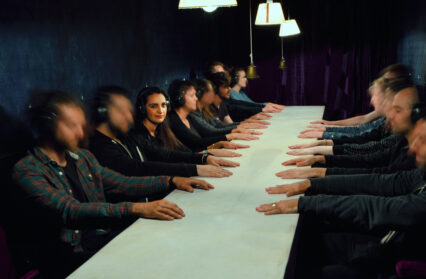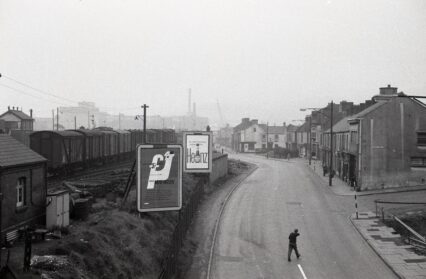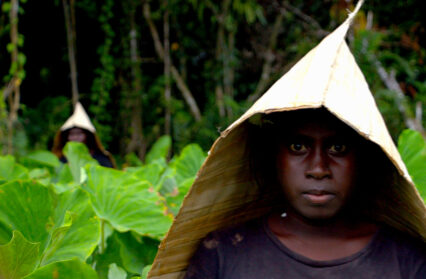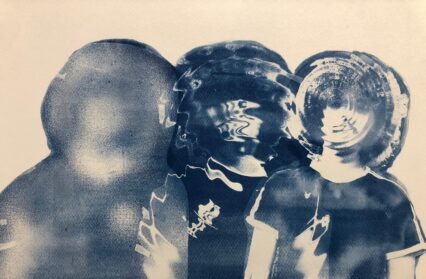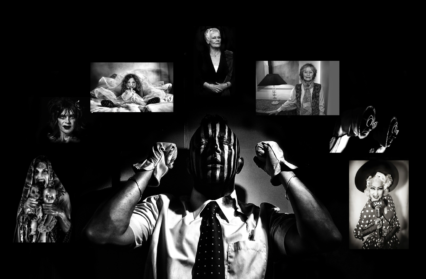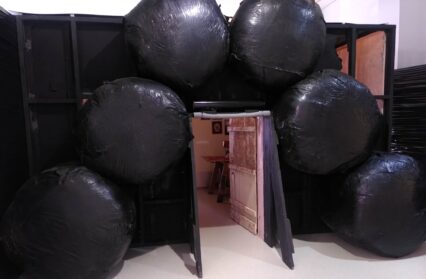As a joint exhibition of the two artists takes place at Oriel Mostyn in Llandudno, S Mark Gubb talks to legendary pop artist Derek Boshier at Derek’s house in Los Angeles.
SMG: I guess a good place to start would be, the first time we met, I remember you becoming quite animated when I told you I lived in Cardiff and you saying, ‘I used to have a cottage in Wales!’ and you ran off and grabbed some photo albums. So, how did that come about? When did you have the cottage?
DB: Basically, it was all of the 70s and in to the 80s, then I moved to Texas to take a job at the University of Houston. So, I still owned the place although I wasn’t there. But I went back and visited every time I came back. The acquisition of the house was very strange. I had gone round to a good friend’s house and we were talking. He asked what I’d been doing, as I hadn’t seen him for several months, and I said, ‘Well, actually I’ve been driving to Wales to see if I can buy a property there.’ I wanted to buy a property and I couldn’t afford to in London and, in a way, I didn’t want to. I liked Wales and I got to know something about the country through many sources.
When I went to the Royal College of Art, in the first year I shared a flat with a Welshman, a very good and well-known artist called John Selway. So, John and I shared these digs and I got to know Wales via him. I’d always had a great interest in Dylan Thomas and I’d been on some visits to Wales and really liked it. In the 50s, 1954 I think it was, when I was living in Dorset and going to Yeovil School of Art in Somerset, three of us took our bicycles and cycled through Wales right up to Snowdonia and we camped out and got soaking wet in tents and stuff. So, I had a background to Wales through various things and I liked it. I knew Scotland a bit, but I tended to like the Welsh culture. I liked its traditions.
There was another reason. My parents, in their 70s, were threatened to be thrown out by their landlord and had nowhere to live, so I rushed down to where they were living, in Slough, and I sorted it out. They said, ‘We’re going to go in to a very good home for people who belonged to the pub and hotel industry.’ It was the second biggest foundation in England called the Licensed Victuallers Association, because after my Dad had been a caretaker he became a landlord in pubs. So I went down and sorted it out and he said that he and my Mum were going to try and get in to a Licensed Victuallers place in Devon as they’d paid in and it was like a trade union. So after that I thought, I better buy myself a property. So, that was another reason.
So, I saw this friend in London in Notting Hill where I was living in the 60s, and in conversation I said, ‘I’ve been down to Wales looking at places, just driving around’, as I had no idea. I went to see a faculty member at the Central School of Art as he had a place. I liked it round there and I stayed at his place whilst I was searching, and in the same room was a woman who said, ‘You’re looking to buy a cottage in Wales?’ and I said, ‘Yes,’ and she said, ‘I’ve got one for sale,’ and I said, ‘Where is it?’ and she said, ‘Well, it’s halfway between Welshpool and Dolgellau.’ ‘Oh,’ I said, ‘What’s it like?’ She said, ‘I don’t know. I’ve only been there once.’ And I said, ‘What do you mean?’ and she said, ‘I bought it without looking at it. I saw an ad in the Times – Cottage For Sale in Wales – and I bought it, without looking at it. I went down to look at it and it’s a ruin really.’ I said, ‘Well, what have you done to it?’ and she said, ‘Nothing.’ So I got the address and it was in a village called Llangadfan and I went to look at it and, yes, there was a hole in the roof and water was coming through, but I went up and looked and it was just three slates missing. I thought, ‘This is great!’
It was so good. The walls were so thick, like dry stone walls and in the middle was horsehair and stuff for insulation, and it had beautiful old windows. Not a big place and I needed more room. So, basically, I negotiated and I bought it. It was outside of the village, actually the last house before the moors began. And right opposite me was a hill, called Pencoed, and there was a thing in the village that anyone who lived in the cottage was called the King of Pencoed. So I’d go to the pub and they’d say, ‘Oh, hello, here’s the King of Pencoed’. The interesting thing about this place was that I altered it and added to it. We dug out all the earth at the back and put in new beams and skylight. So there was a bit of work to do it on it and I just loved it. I loved the position. The hill came right up to the house, which made it very damp. So we dynamited behind it and I added on to the house and then we had to strengthen the beams. The interior was so good. The doors and windows were very thin oak. Very elegant.
I was fascinated by the history of this place. I spoke to a guy called John, who owned the local garage, who was also a local GP, I said, ‘John, can you tell me something about the history of Ffridd Newydd?’And he said, ‘Sure. It was owned for nearly 60 years or so by Big John. He was about 6’4” and just as wide. He was very strong. He was so strong, sometimes, when he and mates went out and got drunk, he’d carry the other farmers back to their place on his back. He married a local girl from Llangadfan and they lived there for nearly 50 years.’ He said, ‘He wasn’t local.’ And I said, ’Oh?’ and he said, ‘No. He came from Foel,’ and Foel is three miles away!
I had nearly an acre altogether and I worked on it a lot. The house was lovely and old and I tried not to touch it and if I needed to do anything I put it back to where it was before. Unfortunately, when I sold it, the guy ripped it out and made it look like a suburban house.
When were you last there?
I think I sold it in about ’82 when I knew I was going to stay in Texas for another few years – though I didn’t think I was going to stay there for 13 years. I did one year in Texas and they said ‘do another year and if you want to stay on we’ll make you a full professor in three years.’And then I got married and had two daughters, so that was good.
The other thing I got very skilled at – in fact local farmers used to come to me and ask my advice – I was the best dry-stone wall maker. I read up about it, as I had dry-stone walls, and I made them. Two sides, nothing in the middle. You make them in two halves. There’s always a hollow in the middle and you fill it in. A good friend of mine, my nearest neighbour, a farmer called Tecwyn, was a marvelous guy and a sheep farmer. All sorts of weathers he was out. I learnt a lot from him.
As you know, I sometimes brought students there, when I taught in the photography department at the Royal College of Art, we’d do field trips. They’d come up for nearly a week, and when I taught on the foundation at Central students came up, and another faculty member came up and we set them projects. They had to come and work. And the photography students took a lot of very good photographs. So, Tecwyn, when I had visitors, he would always come up and see me. It was about a hundred-yard walk from where the road ended and there was a track up to my house, my cottage. And Tecwyn would always come, but he would never come up if I had visitors. And he knew if I had visitors as there were cars parked. I’d look out of my window and I’d see Tecwyn’s car and I’d always have to do the same thing. I’d walk down the hundred yards and he’d always say the same thing to me, ‘Have you strangers?’ and I’d say, ‘Yes, but come and meet them’, and he’d say, ‘I’d love to!’ And he came up and he loved it as they were always fascinating young students. It was just another world. He’d only been to London twice in his life. I learned a lot about sheep farming and all sorts of things from him.
I used to always drive down from my house. It was a bit too far to walk to the village, as I was the most remote cottage. I suppose it was about half or three-quarters of a mile. The lanes were narrow and dangerous as the hedges were six foot tall. This one time I walked down and I came across a farmer I sort-of knew and we stopped to talk and, of course, in the countryside you don’t just say ‘hello’,you stop and talk for fifteen minutes. If ever I took my car to the garage I’d know I’d be there for at least two hours because everyone else was there sitting around a bonfire and chatting. You got all the local gossip and I didn’t want to miss out on that. So, I met this farmer and he told me he had two sheep who had died last week and he was just doing a sheep dip now and about the chemicals, and we’d talk farm talk, to which I didn’t know anything but I learned a lot, and then just as I was about to leave he said to me, ‘Oh Derek, there’s a telegram for you down in the Post Office.’
I purposely didn’t have a telephone but I knew I could be reached within a day because telegrams were in operation then. And I would always get a telegram, because I had people to stay all the time. They loved it. It was so remote and totally different from the city. And someone from the Post Office would always cycle up the hill and bring the telegram to me. So this farmer said to me, ‘There’s a telegram for you down in the Post Office’, and I said, ‘That’s great. I’ll go and get it.’ And before I could say any more he said, ‘It says, arriving noon tomorrow, Dan.’ And that was one of my best friends in England, called Dante, and he was due to come. So what had actually happened, the Post Mistress, when there was a load of people in the Post Office doing work or collecting things, she’s said, ‘There’s a telegram for London Derek’, and she’d read it to everyone. The guy who told me the message wasn’t even in the Post Office, so someone had told him.
The local Post Office was also the local shop, but if you wanted to do a proper shop you’d go in to Welshpool. I went back recently to see the local Milk Bar, which has shut down, but I also used to go to the Town Hall to the auctions. In fact, in my house in Wales, all the furniture came from these sales. They were good. You’d get some lovely stuff.
I used to spend all Christmas there and at least two months in the summer, and every other weekend. I was there a lot. One year I went down, three or four days before Christmas, having meant to go much earlier, but something had happened and I got held up, but I got down there and I hadn’t been in the building for a couple of weeks and it was damp. So the first thing I did, I had one of those beautiful Danish metal wood-burning stoves and they were so great as they heated the house, but you had to do it. So the first thing I did when I arrived was went for dry wood and started the fire up to make sure it was really roaring, then turned it down a bit and went to bed as I was tired. So, next morning I got up and thought, ‘God, I hope the fire’s still on,’ and as I got up out of bed I thought, ouch, I’ve got a pain in the arse. I’d got haemorrhoids. A bad case of piles. So I went down to my refrigerator, where I had my haemorrhoid suppositories. So, I got up, and I used to sleep naked except for a pair of white socks, so I rushed down naked, except for my white socks, and I could tell it was still on but thought I’d better double-check. So I went and double-checked and, great, it was still going and then I went to the kitchen and got a suppository and I was putting this suppository up my arse and I looked round and the Postman’s looking at me through the window. Now, I know what happened after – he went down to the village and said, ‘I went up to the King of Pencoed’s place and he was stark-naked, except for a pair of white socks, shoving something up his arse!’ I loved the people in the village. They were so friendly and so accepting.
Yes, obviously, in the mid-70s, deep in to Wales, it wasn’t a usual thing for a successful artist from London to turn up and buy a cottage in a village like that. I’m not surprised in the slightest to hear that you got on with everybody, but it’s lovely to hear that you had such a good relationship with the villagers.
I went round to all the fairs and stuff when they did all the sheep-dog trials and when visitors came I always took them on the Llanfair Caereinion narrow gauge railway. That was amazing, and it’s still going.
The other thing that was so interesting, as I was learning about the history of the village from various people, they told me that in the Second World War a Nazi German plane had crashed, on the moors, and they roughly told me where it was and I thought I’d never find it, as it was real moorland. There were wild horses on the moors and up on Pencoed. Sometimes you’d see silhouettes of the horses. Anyway, I several times went out to look and one time I found a piece of an aeroplane, just a very small bit, and unbelievably I found a very small tin and there was a Nazi Flag in it, a swastika. Little red and black flag. I mean, to find a thing, an artefact that was maybe part of it. Nothing else in the tin, just the Nazi flag, and it was paper. So small, on a tooth pick.
There were houses out there that were totally deserted. There was a house with no roof. An old farm you could only get to by horseback or walking. I went in and there were cupboards and stuff still in there and clothes in the cupboard and I got a quilt. A quilt made of very working class stuff – tweeds. You know, it’s not fine decorative stuff. I still use it on my bed. It inspired me to do something when my mother and father were getting older. I taught my Mother how to make quilts. I cut out a template for her and told her how to do it. I’ve got her unfinished quilt actually. And that skill came from Wales. I never made them myself but I learned about them.
Do you think that your time in Wales had any lasting impact on the work that you made? Obviously, you’re from Portsmouth, you were living in London, both of which definitely aren’t rural Wales, so in terms of you opting to spend a significant amount of time there it’s an incredibly different landscape and culture that you were within.
When I left the Royal College in ’62 and my career was in the height of flight, we were Pop Artists and everything, I just left and went to live in India – the worst career move, if you like. But I learned so much. I became a much more tolerant person through living in India, and Wales had the same effect – a totally different experience, the countryside. I used to love the retreat. I often was there by myself before friends came for the weekend and I loved that. I got involved and learnt about Eisteddfods and Welsh traditions and I loved those. I think it’s such a great tradition, the Eisteddfod. The poetry and music and the passing down.
One day I went to see my friend Tecwyn and I said, ‘That’s a lovely caravan,’ and he said, ‘Yes, I’m going to burn it’. So I said, ‘Don’t burn it!’ It was lovely, with bow windows. So he said, ‘You can have it. I’ll pull it up on the tractor.’ And he pointed to a different one and I said, ‘No, not that one, the other one.’ And he said, ‘Oh, that’s where I used to keep the sheep.’ My Welsh living taught me to live with caravans, which is why I’ve got another one outside now.
I had another friend and he lived in Laugharne where Dylan Thomas’s writing hut is. So I visited my friend and his wife there. It’s a very interesting place. They had pub laws that even when pubs in the rest of Britain closed at 11pm they stayed open until 2.00 in the morning, because of some ancient law. My friend told me a story that one pub, when tourists came in during the season, they’d put up a very, very, old dartboard and they’d start playing and the tourists would come in and they’d say, ‘That’s Dylan Thomas’s chair over there, he always sat there. Dylan would play darts here too. We could do with a new dartboard but we keep it. Because it was Dylan’s, we keep it up.’ And of course they’d tell stories about what Dylan did and, of course, eventually one of the tourists would offer to buy the board, then they’d just get another one and put it up!
I wanted to ask you as well, a bit about Cardiff. A friend of mine remembers you coming through doing visiting lecturing there…
I did an exhibition in Cardiff but I can’t remember where. It may have been the university. It went to Hull, for sure, and maybe Nottingham. There are some other places and it also went to Edinburgh. The one thing I do remember about that visit to Cardiff is – I’m not a big drinker, I’m an easy drunk, so I have to watch it – and on this trip to Cardiff I’d had quite a lot to drink and they put me in a taxi to the hotel. I’d got my room keys and I went up and when the lift doors opened, right in front of me there was a print, by the French artist Bernard Buffet which I remembered from earlier and I thought, ‘Oh good, at least I’ve got the right floor’, so I was trying my key in the door and someone said, ‘Who’s that?!’ So I looked at my key and it was the wrong door and wrong floor, so I got back in the lift and went to the next floor and when it opened I saw there was the same Bernard Buffet print opposite the lift on every floor. I remember I had a good time in Cardiff. People were very nice.
When I lived in Wales I used to drive up to Dolgellau and up the coast and Lake Vyrnwy. I went back a year ago. We were driving from Montgomery to Llandudno and the rain was so bad that we had to stop driving. We got about half way and all of a sudden it changed and the sun came out and we were by this great reservoir and it was so beautiful. Wales has such a beautiful landscape. And I would go on trips to everywhere – Blaenau Ffestiniog, Portmeirion. I was in Wales and wanted to explore. As I was teaching photography at the Royal College of Art, I’d take photographs and take them back to the photography department where I’d develop them myself. The cottage was so beautiful. I wish I’d kept it.
Derek Boshier is currently exhibiting, with S Mark Gubb, at Oriel Mostyn in Llandudno.


